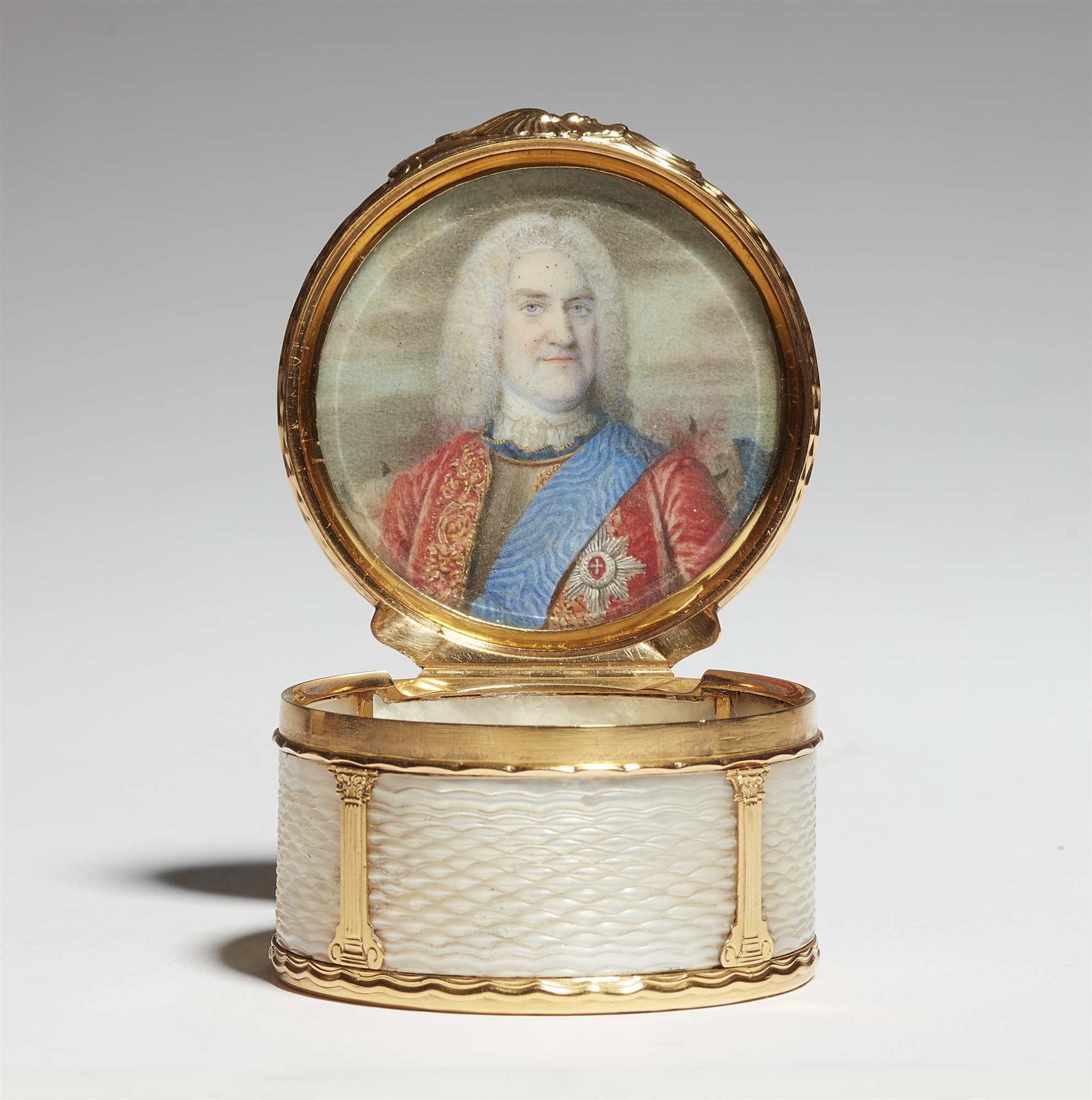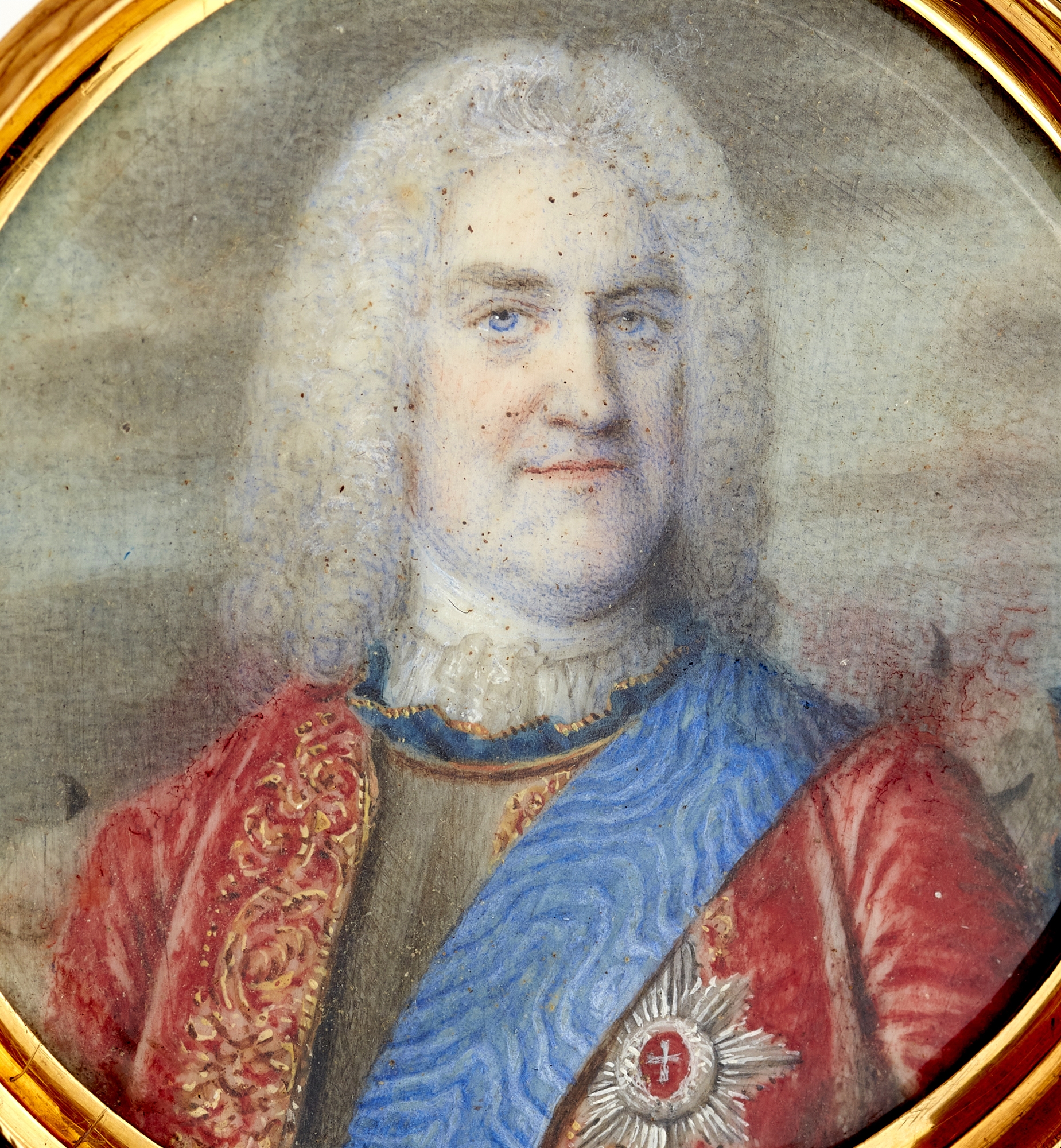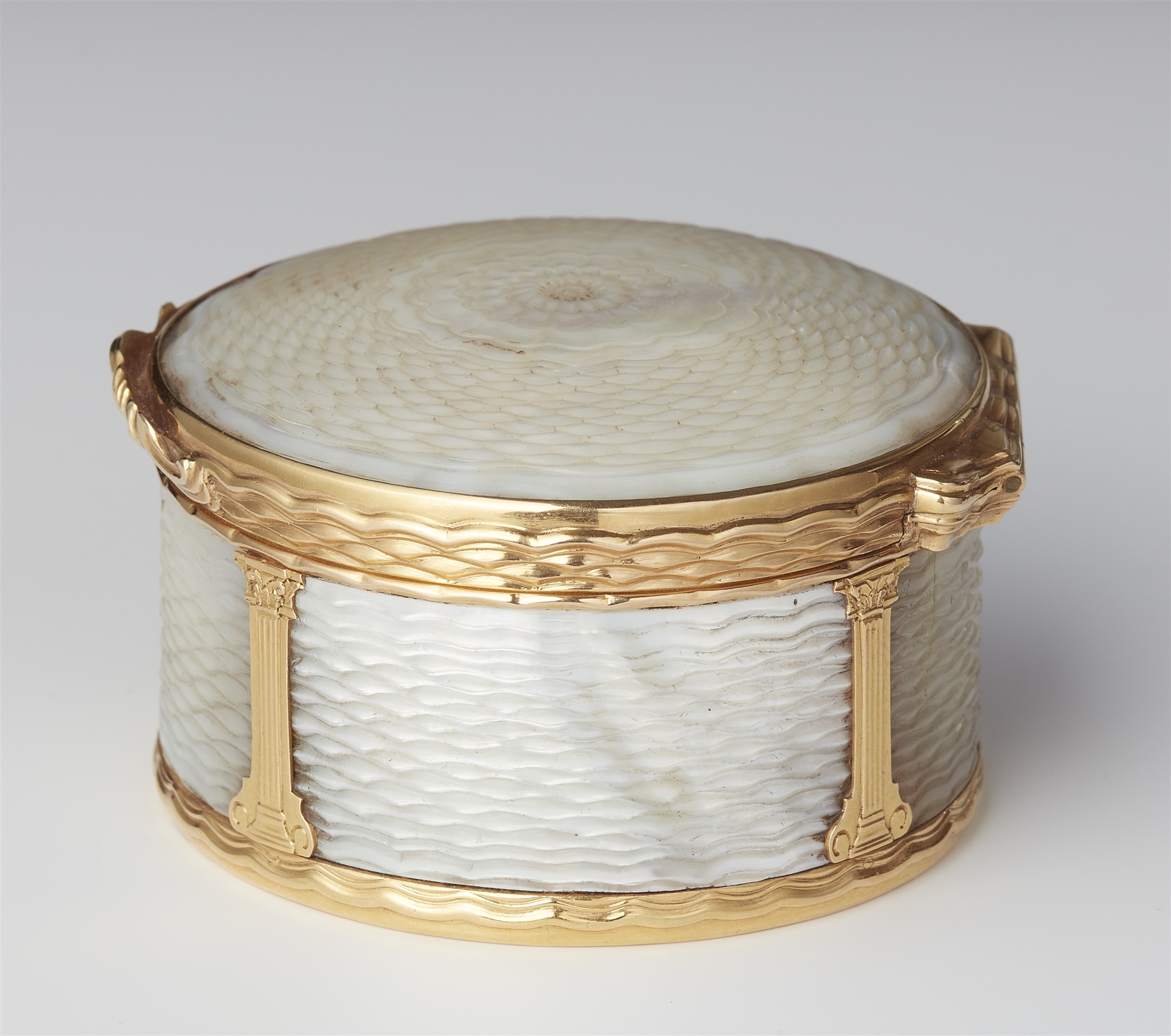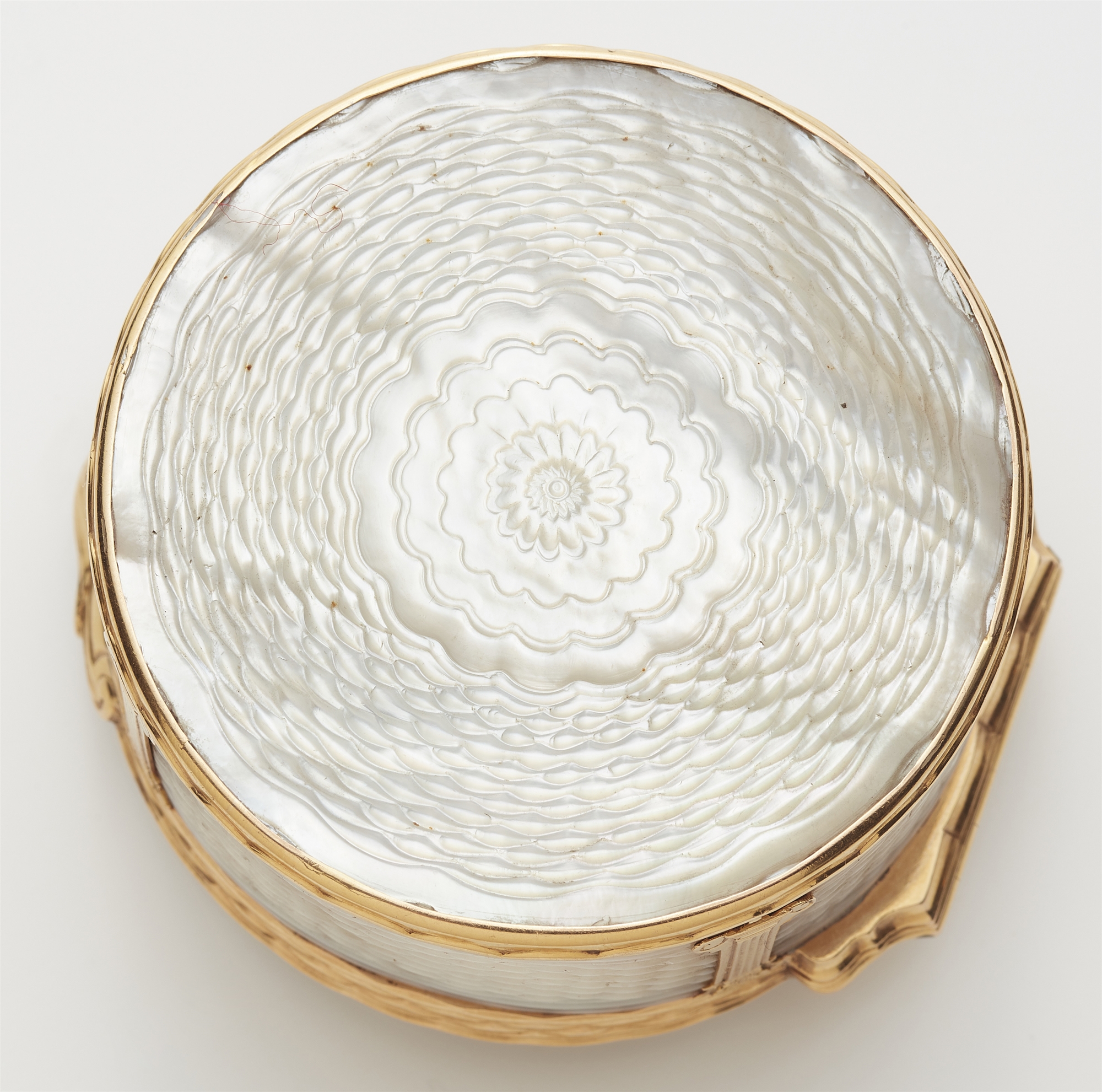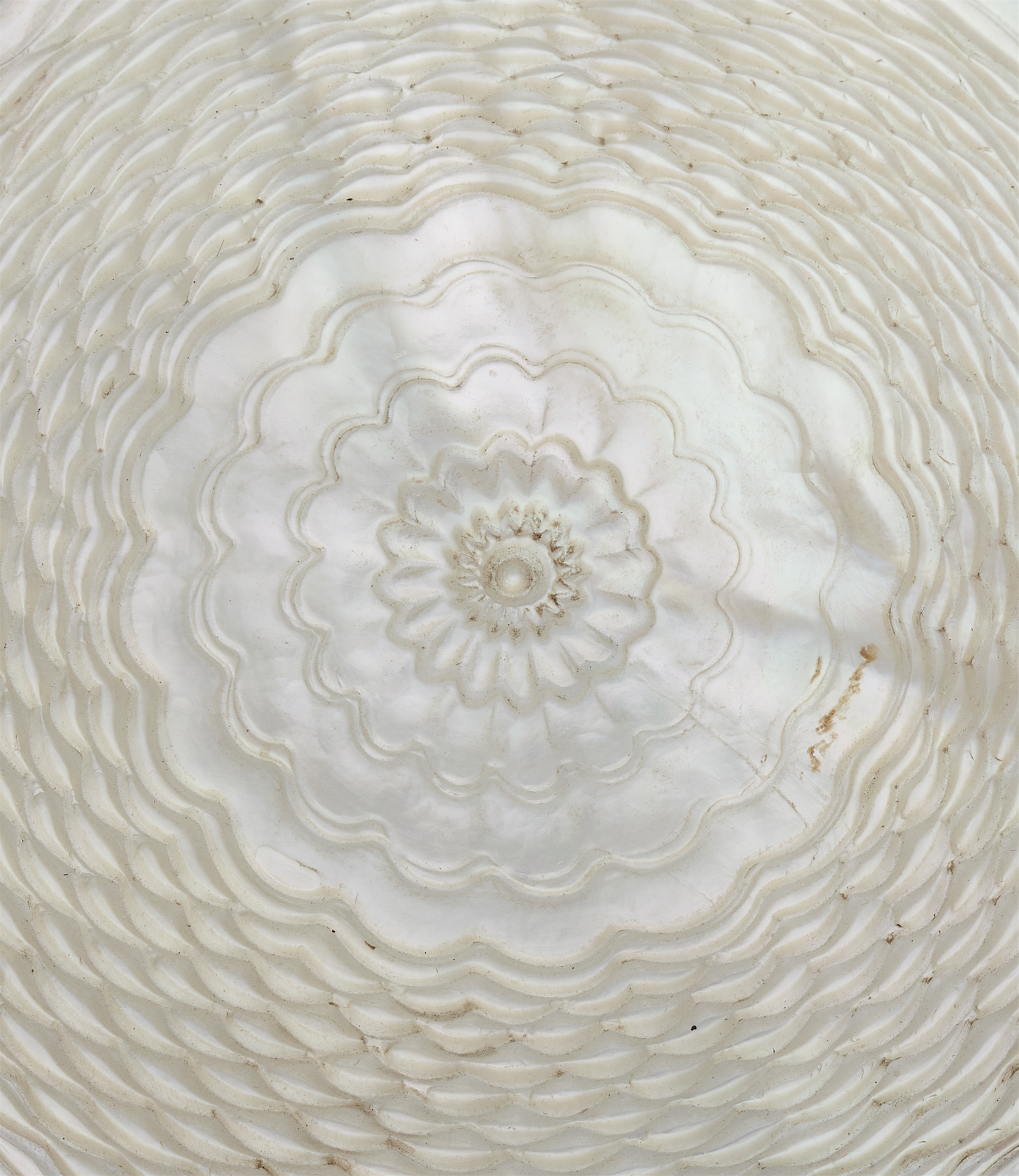501
A German 18k gold and mother of pearl snuff box with portrait of Christian-Ludwig II Duke of Mecklen
Cylindrical box with a slightly domed lid made from mother of pearl plaques set in moulded 18k gold mountings with a shell shaped push button and column motifs. The inside polished, the lid inset with a gouache on ivory portrait of Duke Christian-Ludwig II in a breastplate, embroidered velvet jacket, ermine trimmed cloak and a blue sash with the Danish Order of the Elephant, to which he was accepted in 1737. No hallmarks. With very minor dot shaped moisture damage to the miniature. H 3.5 cm. Diameter 6 cm. Weight 118.27 g.
Berlin, c. 1743. The box possibly workshop Louis Buyrette Widow; the portrait possibly Johann Harper.
Christian Ludwig II of Mecklenburg-Schwerin (Grabow 1683 - 1756 Schwerin) became reigning duke in 1747, after the death of his father Friedrich I. His reign was characterised by a flourishing cultural life. He was a fervent art collector and one of his passions was for shimmering conchyls, for the acquisition of which he built up a large network and appointed various specialists to the court. The archives show that on 4th March 1743 the Duke commissioned the Stockholm-born miniature painter Johann Harper to have four tabatières made, the insides of the lids of which were to be decorated with portraits of the ducal family. One of which was not to be made of solid gold but should have "along the sides cleanly worked mother of pearl and a lid of the same material delicately set in gold... or, if possible and still better and more finely set, whereby the original Smi noble portrait should be used." (translated from the German in Böller/Blübaum, p. 202). The production of the boxes was completed in August 1743 by the Berlin goldsmith Louis Buyrette Witwe, who also worked for King Frederick II of Prussia.
Literature
See Möller/Blübaum, Schimmern aus der Tiefe: Muscheln, Perlen, Nautilus, Staatliches Museum Schwerin 2013, p. 202 ff. fig. 54 almost certainly shows this tabatière in a black-and-white photograph from the 1920s.
This lot contains materials which require a CITES licence for export outside of the EU contract countries. We would like to inform you that such licenses are usually not granted.
18 kt Gelbgold, Gouache auf Elfenbein. Runde Form mit hoher zylindrischer Wandung und leicht gewölbtem Deckel aus Perlmuttplatten mit gedrechseltem Ozier-Relief. Profilierte à cage-Goldmontierung mit muschelförmigem Drücker und vier die Wandung gliedernden, ziselierten korinthischen Pilastern. Innenseiten poliert. Im Deckel unter Glas montiert Miniatur in Tondoform mit Brustbildnis des Herzogs Christian Ludwig II. v. Mecklenburg-Schwerin im Brustharnisch über reich besticktem Samtrock, mit hermelinverbrämtem Mantel, dekoriert mit blauer Schärpe und Bruststern des dänischen Elefantenordens, in den er 1737 aufgenommen worden war. Nicht gestempelt. Miniatur mit minimalen punktförmigen Feuchtigkeitsspuren. H 3,5 cm. Durchmesser 6 cm. Gewicht 118,27 g.
Berlin, um 1743. Die Dose wohl Werkstatt Louis Buyrette Witwe; die Miniatur wohl Johann Harper.
Christian Ludwig II. von Mecklenburg-Schwerin (Grabow 1683 - 1756 Schwerin) wurde 1747, nach dem Tod seines Vaters Friedrich I., regierender Herzog. Seine Amtszeit zeichnete sich durch eine hohe kulturelle Blüte aus. Er war er ein passionierter Kunstsammler und eine seiner Leidenschaften galt den schimmernden Konchylien, für deren Beschaffung er ein großes Netzwerk aufbaute und verschiedene Spezialisten an den Hof berief. Aus den Archivalien geht hervor, dass der Herzog am 4. März 1743 den in Stockholm gebürtigen Miniaturmaler Johann Harper beauftragte, vier Tabatièren herstellen zu lassen, deren Deckelinnenseiten Porträts der herzoglichen Familie zieren sollten. Darunter auch eine, die nicht aus massivem Gold sein sollte sondern "an den Seiten herum von sauber ausgearbeitetem PerleMutter auch der Deckel von ebensolcher Materie und mit Golde zierlich eingefasst seyn...oder, wanns seyn kan noch besser u. netter gefaßt, worzu das Original von Smi hohen Portrait employiret werden soll" (cit. Böller/Blübaum, S. 202). Die Herstellung der Dosen, die im August 1743 fertig waren, übernahm die Berliner Goldschmiede Louis Buyrette Witwe, zu deren Auftraggebern auch König Friedrich II. von Preußen gehörte.
Literatur
Siehe Möller/Blübaum, Schimmern aus der Tiefe: Muscheln, Perlen, Nautilus, Staatliches Museum Schwerin 2013, S. 202 ff. Abb. 54 zeigt mit ziemlicher Sicherheit unsere Tabatière in einer Schwarz-Weiß-Aufnahme aus den 1920er Jahren.
Dieses Objekt wurde unter Verwendung von Materialien hergestellt, für die beim Export in Ländern außerhalb der EU eine Genehmigung nach CITES erforderlich ist. Wir machen darauf aufmerksam, dass eine Genehmigung im Regelfall nicht erteilt wird.
Cylindrical box with a slightly domed lid made from mother of pearl plaques set in moulded 18k gold mountings with a shell shaped push button and column motifs. The inside polished, the lid inset with a gouache on ivory portrait of Duke Christian-Ludwig II in a breastplate, embroidered velvet jacket, ermine trimmed cloak and a blue sash with the Danish Order of the Elephant, to which he was accepted in 1737. No hallmarks. With very minor dot shaped moisture damage to the miniature. H 3.5 cm. Diameter 6 cm. Weight 118.27 g.
Berlin, c. 1743. The box possibly workshop Louis Buyrette Widow; the portrait possibly Johann Harper.
Christian Ludwig II of Mecklenburg-Schwerin (Grabow 1683 - 1756 Schwerin) became reigning duke in 1747, after the death of his father Friedrich I. His reign was characterised by a flourishing cultural life. He was a fervent art collector and one of his passions was for shimmering conchyls, for the acquisition of which he built up a large network and appointed various specialists to the court. The archives show that on 4th March 1743 the Duke commissioned the Stockholm-born miniature painter Johann Harper to have four tabatières made, the insides of the lids of which were to be decorated with portraits of the ducal family. One of which was not to be made of solid gold but should have "along the sides cleanly worked mother of pearl and a lid of the same material delicately set in gold... or, if possible and still better and more finely set, whereby the original Smi noble portrait should be used." (translated from the German in Böller/Blübaum, p. 202). The production of the boxes was completed in August 1743 by the Berlin goldsmith Louis Buyrette Witwe, who also worked for King Frederick II of Prussia.
Literature
See Möller/Blübaum, Schimmern aus der Tiefe: Muscheln, Perlen, Nautilus, Staatliches Museum Schwerin 2013, p. 202 ff. fig. 54 almost certainly shows this tabatière in a black-and-white photograph from the 1920s.
This lot contains materials which require a CITES licence for export outside of the EU contract countries. We would like to inform you that such licenses are usually not granted.
18 kt Gelbgold, Gouache auf Elfenbein. Runde Form mit hoher zylindrischer Wandung und leicht gewölbtem Deckel aus Perlmuttplatten mit gedrechseltem Ozier-Relief. Profilierte à cage-Goldmontierung mit muschelförmigem Drücker und vier die Wandung gliedernden, ziselierten korinthischen Pilastern. Innenseiten poliert. Im Deckel unter Glas montiert Miniatur in Tondoform mit Brustbildnis des Herzogs Christian Ludwig II. v. Mecklenburg-Schwerin im Brustharnisch über reich besticktem Samtrock, mit hermelinverbrämtem Mantel, dekoriert mit blauer Schärpe und Bruststern des dänischen Elefantenordens, in den er 1737 aufgenommen worden war. Nicht gestempelt. Miniatur mit minimalen punktförmigen Feuchtigkeitsspuren. H 3,5 cm. Durchmesser 6 cm. Gewicht 118,27 g.
Berlin, um 1743. Die Dose wohl Werkstatt Louis Buyrette Witwe; die Miniatur wohl Johann Harper.
Christian Ludwig II. von Mecklenburg-Schwerin (Grabow 1683 - 1756 Schwerin) wurde 1747, nach dem Tod seines Vaters Friedrich I., regierender Herzog. Seine Amtszeit zeichnete sich durch eine hohe kulturelle Blüte aus. Er war er ein passionierter Kunstsammler und eine seiner Leidenschaften galt den schimmernden Konchylien, für deren Beschaffung er ein großes Netzwerk aufbaute und verschiedene Spezialisten an den Hof berief. Aus den Archivalien geht hervor, dass der Herzog am 4. März 1743 den in Stockholm gebürtigen Miniaturmaler Johann Harper beauftragte, vier Tabatièren herstellen zu lassen, deren Deckelinnenseiten Porträts der herzoglichen Familie zieren sollten. Darunter auch eine, die nicht aus massivem Gold sein sollte sondern "an den Seiten herum von sauber ausgearbeitetem PerleMutter auch der Deckel von ebensolcher Materie und mit Golde zierlich eingefasst seyn...oder, wanns seyn kan noch besser u. netter gefaßt, worzu das Original von Smi hohen Portrait employiret werden soll" (cit. Böller/Blübaum, S. 202). Die Herstellung der Dosen, die im August 1743 fertig waren, übernahm die Berliner Goldschmiede Louis Buyrette Witwe, zu deren Auftraggebern auch König Friedrich II. von Preußen gehörte.
Literatur
Siehe Möller/Blübaum, Schimmern aus der Tiefe: Muscheln, Perlen, Nautilus, Staatliches Museum Schwerin 2013, S. 202 ff. Abb. 54 zeigt mit ziemlicher Sicherheit unsere Tabatière in einer Schwarz-Weiß-Aufnahme aus den 1920er Jahren.
Dieses Objekt wurde unter Verwendung von Materialien hergestellt, für die beim Export in Ländern außerhalb der EU eine Genehmigung nach CITES erforderlich ist. Wir machen darauf aufmerksam, dass eine Genehmigung im Regelfall nicht erteilt wird.
Jewellery and Watches
Sale Date(s)
Venue Address
Please contact: shipping@lempertz.com
Tel.: 0049 221 925729 19
Important Information
Cologne
Vernissage Thursday, 9 Nov, 6 pm
Friday, 10 Nov, 10 am - 5.30 pm
Saturday, 11 Nov, 10 am - 4 pm, by appointment only
Sunday, 12 Nov, 11 am - 4 pm
Monday, 13 Nov - Wednesday, 14 Nov, 10 am - 5.30 pm
In selection
Munich, St. Anna-Platz 3
Monday, 6 Nov and Tuesday, 7 Nov, 10 am - 5 pm
Terms & Conditions
Conditions of sale
1. The art auction house, Kunsthaus Lempertz KG (henceforth referred to as Lempertz), conducts public auctions in terms of § 383 para. 3 sentence 1 of the Handelsgesetzbuch (the Commercial Code). as commissioning agent on behalf of the accounts of submitters, who remain anonymous. With regard to its auctioneering terms and conditions drawn up in other languages, the German version remains the official one.
2. The auctioneer reserves the right to divide or combine any catalogue lots or, if it has special reason to do so, to offer any lot for sale in an order different from that given in the catalogue or to withdraw any lot from the sale.
3. All lots put up for sale may be viewed and inspected prior to the auction. The catalogue specifications and related specifications appearing on the internet, which have both been compiled in good conscience, do not form part of the contractually agreed to conditions. These specifications have been derived from the status of the information available at the time of compiling the catalogue. They do not serve as a guarantee in legal terms and their purpose is purely in the information they provide. The same applies to any reports on an item’s condition or any other information, either in oral or written form. Certificates or certifications from artists, their estates or experts relevant to each case only form a contractual part of the agreement if they are specifically mentioned in the catalogue text. The state of the item is generally not mentioned in the catalogue. Likewise missing specifications do not constitute an agreement on quality. All items are used goods and are sold as seen.
4. Warranty claims are excluded. In the event of variances from the catalogue descriptions, which result in negation or substantial diminution of value or suitability, and which are reported with due justification within one year after handover, Lempertz nevertheless undertakes to pursue its rights against the seller through the courts; in the event of a successful claim against the seller, Lempertz will reimburse the buyer only the total purchase price paid. Over and above this, Lempertz undertakes to reimburse its commission within a given period of three years after the date of the sale if the object in question proves not to be authentic. The used items are sold in public auction in which the bidder/buyer can participate in Person. The legal stipulations concerning the sale of consumer goods are not to be applied according to § 474 para. 1 sentence 2 of the Bürgerliches Gesetzbuch (the Civil Code, „BGB“).
5. Claims for compensation as the result of a fault or defect in the object auctioned or damage to it or its loss, regardless of the legal grounds, or as the result of variances from the catalogue description or statements made elsewhere due to violation of due dilligence according to §§ 41 ff. of the Kulturgutschutzgesetz (the Cultural Property Protection Act) are excluded unless Lempertz acted with wilful intent or gross negligence; the liability for bodily injury or damages caused to health or life remains unaffected. In other regards, point 4 applies.
6. Submission of bids. Lempertz reserves the right to approve bidders for the auction and especially the right to make this approval dependent upon successful identification in terms of § 1 para. 3 of the Geldwäschegesetz (the Money Laundering Act, “GWG”). Bids in attendance: The floor bidder receives a bidding number on presentation of a photo ID. If the bidder is not known to Lempertz, registration must take place 24 hours before the auction is due to begin in writing on presentation of a current bank reference. Bids in absentia: Bids can also be submitted either in writing, telephonically or via the internet. The placing of bids in absentia must reach Lempertz 24 hours before the auction to ensure the proper processing thereof. The item must be mentioned in the bid placed, together with the lot number and item description. In the event of ambiguities, the listed lot number becomes applicable. The placement of a bid must be signed by the applicant. The regulations regarding revocations and the right to return the goods in the case of long distance agreements (§ 312b-d BGB) do not apply. Telephone bids: Establishing and maintaining a connection cannot be vouched for. In submitting a bid placement, the bidder declares that he agrees to the recording of the bidding process. Bids via the internet: They will only be accepted by Lempertz if the bidder registered himself on the internet website beforehand. Lempertz will treat such bids in the same way as bids in writing.
7. Carrying out the auction: The hammer will come down when no higher bids are submitted after three calls for a bid. In extenuating circumstances, the auctioneer reserves the right to bring down the hammer or he can refuse to accept a bid, especially when the bidder cannot be successfully identified in terms of § 1 para. 3 GWG. If several individuals make the same bid at the same time, and after the third call, no higher bid ensues, then the ticket becomes the deciding factor. The auctioneer can retract his acceptance of the bid and auction the item once more if a higher bid that was submitted on time, was erroneously overlooked and immediately queried by the bidder, or if any doubts regarding its acceptance arise. Written bids are only played to an absolute maximum by Lempertz if this is deemed necessary to outbid another bid. The auctioneer can bid on behalf of the submitter up to the agreed limit, without revealing this and irrespective of whether other bids are submitted. Even if bids have been placed and the hammer has not come down, the auctioneer is only liable to the bidder in the event of premeditation or gross negligence. Further information can be found in our privacy policy at www.lempertz.com/ datenschutzerklärung.html
8. Once a lot has been knocked down, the successful bidder is obliged to buy it. If a bid is accepted conditionally, the bidder is bound by his bid until four weeks after the auction unless he immediately withdraws from the conditionally accepted bid. From the fall of the hammer, possession and risk pass directly to the buyer, while ownership passes to the buyer only after full payment has been received.
9. Up to a hammer price of € 600,000 a premium of 26 % calculated on the hammer price plus 19 % value added tax (VAT) calculated on the premium only is levied. The premium will be reduced to 20 % (plus VAT) on any amount surpassing € 600,000 (margin scheme). On lots which are characterized by N, an additional 7 % for import tax will be charged. On lots which are characterized by an R, the buyer shall pay the statutory VAT of 19 % on the hammer price and the buyer’s premium (regular scheme). To lots characterized by an R which are sold and send to a private person in another EU member state, the VAT legislation of this member state is applied, § 3c of the Umsatzsteuergesetz (VAT-Act). Exports to third (i.e. non-EU) countries will be exempt from VAT, and so will be exports made by companies from other EU member states if they state their VAT identification number. For original works of art, whose authors are either still alive or deceased for less than 70 years (§ 64 of the Urheberrechtsgesetz (Act on Copyright and Related Rights), a charge of 1.8 % on the hammer price will be levied for the droit de suite. For payments which amount to € 10,000.00 or more, Lempertz is obliged to make a copy of the photo ID of the buyer according to §3 GWG. This applies also to cases in which payments of € 10,000.00 or more are being made for more than one invoice. If a buyer exports an object to a third country personally, the VAT will be refunded, as soon as Lempertz receives the export and import papers. All invoices issued on the day of auction or soon after remain under provision.
10. Successful bidders shall forthwith upon the purchase pay to Lempertz the final price (hammer price plus premium and VAT) in Euro. Bank transfers are to be exclusively in Euros. We accept payment by cryptocurrencies. The invoice will be send by email unless the buyer asks Lempertz to send them by mail. The request for an alteration of an auction invoice, e.g. to a person other than the bidder has to be made immediately after the auction. Additional fees may apply for the alteration. The transfer is subject to successful identification (§ 1 para. 3 GWG) of the bidder and of the person to whom the invoice is transferred. Invoices will only be issued to those persons actually responsible for settling the invoices.
11. In the case of payment default, Lempertz will charge 1% interest on the outstanding amount of the gross price per month. If the buyer defaults in payment, Lempertz may at its discretion insist on performance of the purchase contract or, after allowing a period of grace, claim damages instead of performance. In the latter case, Lempertz may determine the amount of the damages by putting the lot or lots up for auction again, in which case the defaulting buyer will bear the amount of any reduction in the proceeds compared with the earlier auction, plus the cost of resale, including the premium.
12. Buyers must take charge of their purchases immediately after the auction. Once a lot has been sold, the auctioneer is liable only for wilful intent or gross negligence. Lots will not, however, be surrendered to buyers until full payment has been received. Without exception, shipment will be at the expense and risk of the buyer. Purchases which are not collected within four weeks after the auction may be stored and insured by Lempertz on behalf of the buyer and at its expense in the premises of a freight agent. If Lempertz stores such items itself, it will charge 1 % of the hammer price for insurance and storage costs.
13. As far as this can be agreed, the place of performance and jurisdiction is Cologne. German law applies; the German law for the protection of cultural goods applies; the provisions of the United Nations Convention on Contracts for the International Sale of Goods (CISG) are not applicable. Should any provision herein be wholly or partially ineffective, this will not affect the validity of the remaining provisions. Regarding the treatment of personal data, we would like to point out the data protection notice on our website.
Henrik Hanstein, sworn public auctioneer
Isabel Apiarius-Hanstein, auctioneer











